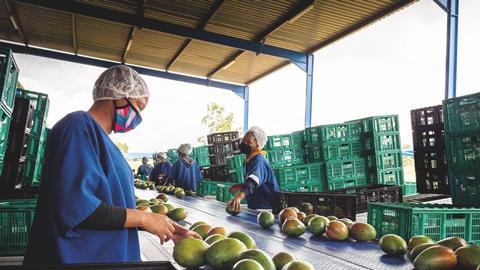Tropical fruit is enjoying promising UK sales growth as new shoppers buy into the category and suppliers focus on resilience amid climatic and logistical challenges
Within the wider fresh produce category, tropical fruit remains something of a niche. Even the more established products like mango and pineapple cannot yet be considered staples, but the category is on the up – as demonstrated by strong sales growth of 15.6 per cent (value) and 6.1 per cent (volume) in 2024, according to Kantar.
Per Hogberg of major tropical fruit supplier Wealmoor puts this down to improved accessibility, competitive pricing, and consumer appetite for variety. He notes that shoppers are becoming more adventurous within the core tropical lines of mango, pineapple and pomegranate. Meanwhile, lesser-known fruits – such as figs, and to some extent dragon fruit, guava and mangosteen – are also gaining year-on-year market share.
The rise of the discounters has further democratised the category, Hogberg says, attracting new shoppers and increasing market penetration – often through aggressive promotional and seasonal listings.
Figs and passion fruit are both enjoying strong growth, driven by increased consumer curiosity and affordability, according to Wealmoor. And prepared fruit continues to play a key role in the wider category, with mango, pineapple and pomegranate dominating the segment and driving overall demand for tropical fruits.
Mango is central to this growth, says Mark Moody of prepared fruit specialist Blue Skies. Kantar data reveals that increased sales are being driven by existing consumers purchasing mango more frequently, as well as new customers buying into the category. Consistency of quality has been key to recent sales growth in mango, Moody says. And in pineapple, Blue Skies is increasingly offering the Smooth Cayenne variety from Benin thanks to its “superior flavour and longer life”.
When it comes to growing conditions, there have been some significant challenges over the past year. “El Niño and its aftereffects in South America, as well as climate volatility more generally, have been key factors,” says Hogberg. Wealmoor is the majority owner of Sunshine, the largest mango exporter in Peru, and Hogberg reports that Peruvian mangoes suffered a “once in a 30-40-year seasonal catastrophe” last year. Thankfully, a cooler winter resulted in “excellent flowering”, albeit with smaller fruit sizes. In Ghana, Brazil and Egypt, meanwhile, Blue Skies reported good mango harvests in 2024.
In pomegranate, Blue Skies says there have been “consistent improvements” in the fruit coming out of Egypt thanks to new varieties and sourcing from new farms. However, Hogberg reports that in coconut Ivory Coast has had issues with the age of plantations and the quality of the crop. As a result, the country has lost market share to India, which is now supplying the majority of European coconut. This, in turn, has created sea freight challenges out of the Red Sea and higher prices over the past nine months.
When it comes to pineapple, Hogberg says adverse weather in Costa Rica impacted quality and volumes. This highlights the hurdles suppliers now face in maintaining consistent supply amid changing climate conditions.
“Climate change has intensified agronomic challenges, including irregular flowering cycles and increased susceptibility to pests and diseases,” he says. “It also drives variability in fruit size, quality, and harvest schedules. And adapting to these changes requires significant investment in sustainable farming practices and close collaboration with our grower partners.”
Moody adds that climate change makes the “unavoidable pinch points” in the season more troublesome, driving the need to build additional resilience into each seasonal plan. “Accordingly, we are investing in new varieties, new country sources, and changing agronomy techniques to improve the resilience of our offer,” he says.
When it comes to logistics, global shipping disruptions remain a challenge, particularly with increased competition for reefers and rerouted shipping lanes. Competition for bookings – particularly with the blueberry and table grape sectors, not to mention a bumper Chilean cherry harvest – have pushed sea-freight rates to nearly double those of the previous season.
But Hogberg says Wealmoor has used its supply chain expertise to maintain continuity. Explore Fresh, its subsidiary which grows and sources fresh exotic produce from Peru, has been instrumental in securing shipping space during challenging periods. And while airfreight remains essential for certain products like papaya, Wealmoor continues to look at ways to shift more volume to sea freight.
Blue Skies, for its part, is an airfreight business, and in response to certain European retailers moving to ban or restrict airfreighted produce, it embarked on a project called Fairmiles in 2023. The campaign calls on policymakers from government and the private sector to consider sustainability impacts on developing countries when pursuing carbon-reduction strategies to minimise ‘food miles’, particularly with regard to airfreighted produce.
Looking ahead to 2025, Moody says Fairmiles has “an exciting line-up” of activities planned, including stakeholder consultations, further research, enhanced communications, and the development of climate justice guidelines tailored to the food industry.




